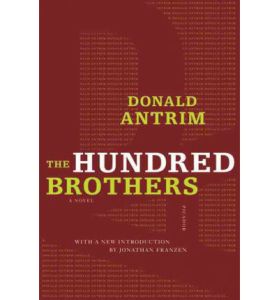Antrim, Donald (1997). The Hundred Brothers. New York: Picador, 188 pp.
Ninety-nine brothers convene at their dead father’s estate to find his ashes and bury him (one brother couldn’t make it). They meet in a vast library that seems to contain all the knowledge of western civilization. The tale is told by Doug, the family genealogist. He describes 99 quirky personalities who tease and abuse each other, the way many brothers do. Drinks are served; dinner is served, but the brothers never do find the ashes, because quarreling, then fighting degenerate into chaos at an exponential rate, until in the end, everything is destroyed, including the library.
The book is famous for its first sentence, running two and a half pages, in which all 100 brothers are named and described. Also notable, the book has no chapter breaks. Scenes come into focus as Doug the narrator moves about the library, encountering this brother then that one, but the whole book is one chapter.
The writing is engaging but the problem for me is that it wasn’t about anything. People and things and situations are described and evaluated and Doug’s ironic and self-effacing tone is supposed to be humorous, but it runs into the problem any first-person narrator faces: nobody is really interesting enough to hold a reader’s attention for a whole novel, not even Humbert Humbert, so the author better have something else up his sleeve, and usually it’s the plot. But this novel has no plot.
Things happen, arbitrarily, haphazardly, randomly. An old brother falls asleep; a blind one falls down; a vase is broken; the lights go out; bats fly from the chimney; the Doberman barks; snow blows in the windows; the ceiling leaks; there’s not enough to eat or drink. Many of these events are supposed to be humorous, but they struck me as implausible and farcical. Even the narrator’s emotions don’t track any logic. At one moment he is seized by panic; the next by maudlin sentimentality; and in the next, he has to pee. This story lacks causal connective tissue, so technically, it’s a report, or a description, not a story at all.
Any novel can be saved by highly compelling language, even if little else is going on. Lolita is a good example of that. But Antrim’s language, while engaging, and often amusing, is not lyrical or exceptional. What about strong characters then? A hundred of them to choose from here. A selection of the brothers is described in eccentric caricatures. These are supposed to be funny, and some are clever, but none reveal much about character. The set never changes – the whole novel takes place in the library, and the time hardly varies – few flashbacks or reminiscences. So add it all up and what do you have? Some madcap entertainment and writing for the sake of writing.
There is, however, an undercurrent of deep mythical and symbolic movement that emerges powerfully at the very end, and in retrospect, one can see how it was set up from the beginning. The destruction of the library represents postmodern nihilism, and the ritual ceremony at the end does the same, with a fantastic blend of imagery from ancient Mayan sacrifices and the Cruxifiction. The barking Doberman stands for the mindless pandemonium of modern life, and Doug’s delusional visions of his father are a yearning for a time of meaning long lost. And much more. Ultimately the thesis is a protest, or at least a wail, against postmodernism and a longing for the innocent beliefs of modernism when things seemed to mean something, as they did in childhood.
So the thematic element of the book is its strong point, all the more so since that element is presented indirectly, in a postmodern fashion (!) and must be inferred by the reader after the fact. This is a neat trick and an artistic accomplishment that makes wading through the novel very worthwhile. This is a book best enjoyed on the second read, after you realize what the subterranean message is, but in order to get a satisfying second read, you must endure a grating first read. Is it worth it? Definitely. It’s a brilliant work of art.

